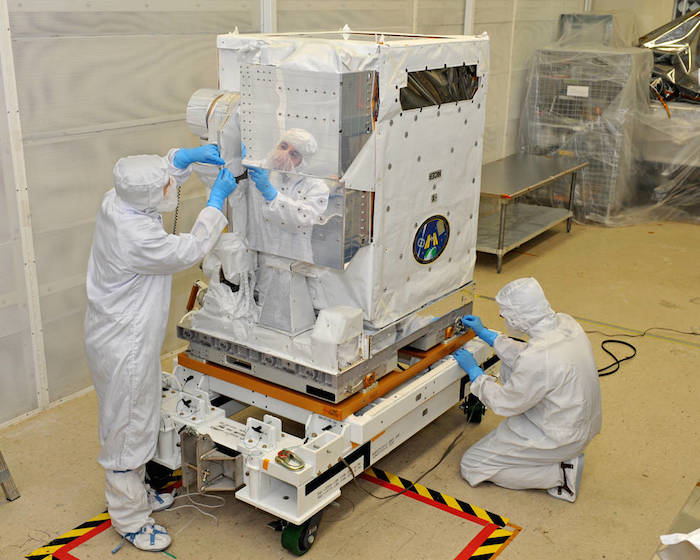.

A view of the Neutron star Interior Composition Explorer (NICER) X-ray Timing Instrument without its protective blanketing shows a collection of 56 close-packed sunshades—the white and black cylinders in the foreground—that protect the X-ray optics, as well as some of the 56 X-ray detector enclosures, on the gold-colored plate, onto which X-rays from the sky are focused.
NICER, an upcoming NASA astrophysics mission, will uncover the physics governing the ultra-dense interiors of neutron stars. Using the same platform, the mission will demonstrate trailblazing space navigation technology.
The NICER mission arrived at NASA’s Kennedy Space Center in Cape Canaveral, Florida, on June 8, 2016. Currently scheduled for launch to the International Space Station in February 2017 aboard a SpaceX Dragon cargo spacecraft, NICER will deploy as an external attached payload on the ISS ExPRESS Logistics Carrier 2. Its 56 X-ray optics and silicon detectors will observe and gather data about the interior composition of neutron stars and their pulsating cohort, pulsars.
Quelle: NASA
-
NASA’s NICER Mission Arrives at Kennedy Space Center
An upcoming NASA astrophysics mission will uncover the physics governing the ultra-dense interiors of neutron stars. Using the same platform, the mission will demonstrate trailblazing space navigation technology.
The multipurpose Neutron star Interior Composition Explorer (NICER) mission arrived at NASA’s Kennedy Space Center in Cape Canaveral, Florida, on Wednesday, June 8. The forthcoming International Space Station (ISS) payload was transported from NASA’s Goddard Space Flight Center in Greenbelt, Maryland, aboard a climate-controlled, air-suspension truck.
.

NICER Mechanical Engineer Steven Kenyon (left) and GPS and Star Tracker Camera Engineer Eric Rogstad (right) prepare NICER for shipment to Kennedy Space Center in Florida. The payload will be deployed on the International Space Station (ISS) in early 2017.
Credits: Barbara Lambert
-
A neutron star begins its life as a star approximately 10 times the mass of the sun. When its nuclear fuel is exhausted, the star’s outer layers explode in a supernova. Crushed by its own gravity, the star’s core collapses and forms a neutron star. These collapsed stellar corpses are the densest, most strongly magnetic and most rapidly spinning objects known in the universe.
Neutron stars, which squeeze up to twice the sun’s mass into a city-size volume, are powerfully bound by gravity that is exceeded only around black holes. Theory has advanced a host of models to describe the physics of neutron star interiors, including the very nature of high-density matter that cannot be produced in any laboratory on Earth. NICER’s astrophysical observations will test these models.
Some rapidly rotating neutron stars, called pulsars, are cosmic lighthouses that sweep narrow beams of radiation through space as they spin. Pulsars can spin up to hundreds of times every second, producing flashes of light from radio through gamma rays detected at Earth with clock-like regularity. NICER will exploit these pulsations to perform cutting-edge astrophysics investigations while another aspect of the mission – the Station Explorer for X-ray Timing and Navigation Technology (SEXTANT) project – demonstrates a technological first: real-time, autonomous spacecraft navigation using pulsars as beacons, ultimately furthering deep space exploration into the solar system and beyond.
NICER's X-ray Timing Instrument (XTI) offers an unprecedented combination of capabilities to view the emissions of neutron stars in “soft” X-ray light (less energetic than the X-rays typically used for medical imaging). A bundle of 56 co-aligned optics and X-ray sensors, the instrument represents an innovative configuration of flight-proven components, minimizing risk and meeting the science investigation’s demands of fast timing and the ability to measure the energies of detected X-ray photons.
“Thanks to a terrific development team, we’re pleased to have delivered NICER two weeks ahead of our original schedule crafted almost four years ago,” said Keith Gendreau, NICER’s principal investigator at Goddard. “We’re looking forward to launching on a SpaceX rocket and integrating with the International Space Station. From this platform, NICER will provide both unique insights into neutron star physics and validation of a technology that may one day lead humanity into deep space.”
NICER will operate from the ExPRESS Logistics Carrier 2 on the ISS after launch, extraction from the transfer vehicle and installation. NICER is planned for launch from Cape Canaveral Air Force Station in Florida aboard the SpaceX-11 ISS Commercial Resupply Services flight, currently scheduled for February 2017. The baseline mission lifetime is 18 months. The NICER team anticipates initial science results by late summer 2017.
Keith Gendreau and Zaven Arzoumanian are the mission’s principal and deputy principal investigators, respectively. NASA Goddard provides overall mission design, development, management, science leadership, system engineering as well as payload integration, testing and flight operations. Partners from industry and academia include Moog Inc., the Technical University of Denmark and the Massachusetts Institute of Technology.
NICER is an Astrophysics Mission of Opportunity within NASA’s Explorer program, which provides frequent flight opportunities for world-class scientific investigations from space utilizing innovative, streamlined and efficient management approaches within the heliophysics and astrophysics science areas. NASA’s Space Technology Mission Directorate supports the SEXTANT component of the mission, demonstrating pulsar-based spacecraft navigation.
Quelle: NASA
5270 Views
